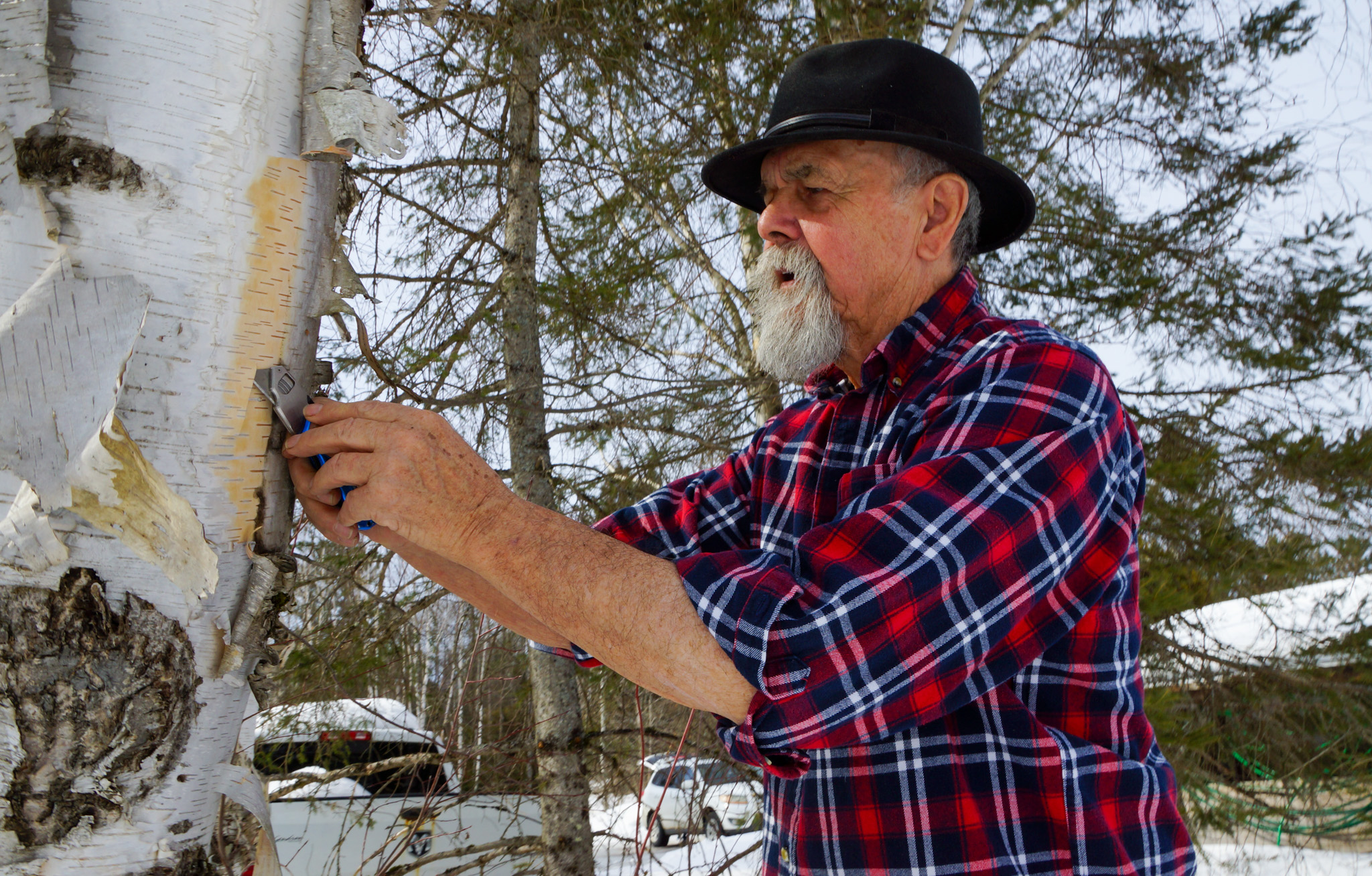
Pinock Smith harvests birch bark outside his workshop in Kitigan Zibi, a roughly 2-hour drive from Ottawa. “The material lasts forever,” he said. “Birch bark doesn’t rot.” [Photo © Julia Stratton]
Peeling back climate change’s impact on traditional birch crafts in Kitigan Zibi
How an Algonquin artist is keeping the tradition of building birch bark canoes alive. But, as harvesting birchbark becomes increasingly difficult because of climate change, how will artists like Smith adapt to an uncertain future?
By: Sarah St-Pierre, Jacksen Friske, Julia Stratton, Trent Misev
Wood scraps and split logs often litter the floor of Pinock Smith’s workshop. But the shrew mole scurrying around is new. “I don’t have the heart to kill him,” Smith says. He pours water on the ground for the critter. “It can stay for now, but once I host a workshop it will have to go.”
Smith is a craftsman from Kitigan Zibi Anishinabeg First Nation. He specializes in Algonquin woodworking, crafting everything from toboggans to birchbark canoes.
In his youth, he harvested his materials from traditional Algonquin land himself, and still does, but Smith now also relies on his many connections throughout the community to help source his craft. Hosting workshops has allowed him to both pass on his craft — such as making mini canoes and portable containers for matches out of birchbark — and teach others the harvesting process passed onto him by his Elders and community.
Wiigwaas — Anishinaabemowin for birchbark — is a key material in his workshop. He uses it the way his ancestors did. Stockpiling the bark allows Smith to work on projects outside of harvesting season. By boiling water in a kettle and pouring it on hardened birchbark in a plastic bin to replicate freshly harvested bark’s pliability, Smith can curl it into cone-shaped moose callers that mimic the bellow of a moose. Larger pieces can be bent to make dome-shaped wigwams.
He has been crafting wiigwaas into canoes for 30 years, using not a single nail, screw, bolt or blob of glue. “The only thing holding it together is a spruce root,” he says. “It’s very simple, and it took a lot of knowledge to get to that point.”
Smith learned his craft as a youth using “the three Ls” — looking, listening and learning. Watching family and community members create their own canoes and baskets and tan hides, Smith picked up the process of “making all the things that they needed for day-to-day life.”
After years of helping others make canoes, Smith made his first full-size canoe alongside his uncle about 35 years ago. They loaded up the truck with chainsaws, a file and gas, then left with plenty of room in the cargo bed. “I want to come back, and the back of my truck should be full of bark,” Smith says.
At the time, he says, there were plenty of trees to choose from. So they found a nice tree, cut it down and made an incision to take off the birchbark. But although there were many other trees around, they left with only the one. “That occurred to me after that’s because that’s the way I was raised,” Smith said. “Take what you need. Don’t take 15 trees.”
The sustainability and ingenuity of Algonquin crafting techniques helped Smith ignore the negative public opinion about Indigenous people by connecting him to the wisdom of his ancestors, he says. “It gives you some insight into their knowledge, their experience and their intelligence,” he says. He admires what they were able to accomplish with the natural resources in their territory. “It gives you pride in your ancestors, and that, in turn, gives you a little bit of pride in who you are.”
Over the course of his lifetime, however, it has gotten harder for him to find quality birchbark for his craft. As climate change brings drought and rising temperatures, the birch tree’s ecosystem in Kitigan Zibi is changing — and so is its bark.
Chasing the perfect bark has pushed Smith’s harvesting lessons farther and farther from his community, but the motivation from both teacher and students stays close to home.
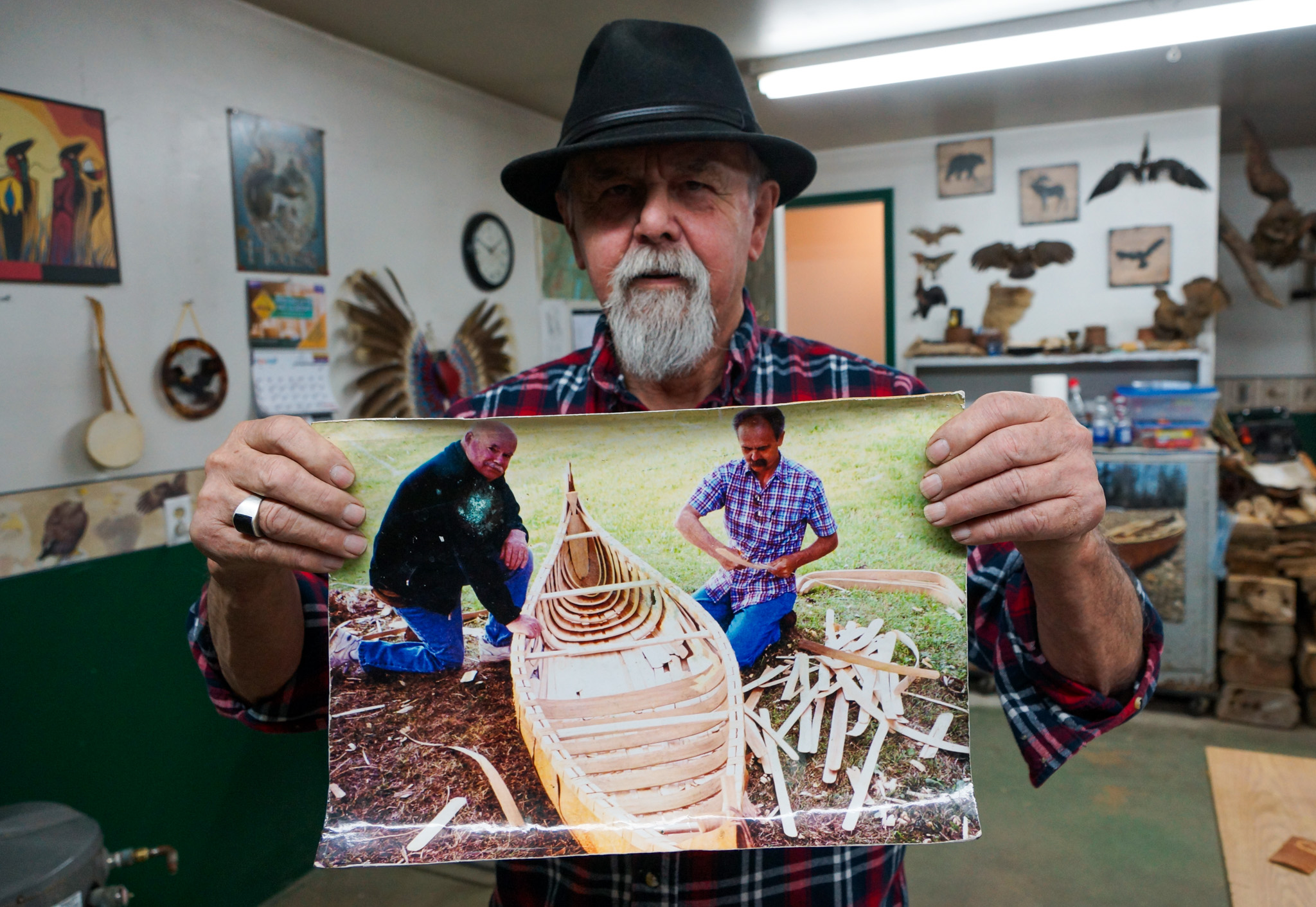
P
Dolcy Meness, a Nagadjitòdjig Akì Guardian, has heard about birchbark concerns from community and family members — and seen them first-hand. Meness monitors the nation’s ancestral territory and engages with the community to combine science and traditional knowledge in Kitigan Zibi. From surveying areas throughout the territory such as Baskatong, Papineau-Labelle, Jim Lake, Sheenboro and Lac Bryson, she says she’s only noticed about five large birch trees that are more than 60 centimetres in diameter. Most are small to medium-sized, around 30 centimetres across.
“What people have been noticing, especially the older people who work with birchbark a lot, [is they] have seen that there’s too much heat during the summer; the weather is a little bit unpredictable,” Meness says. Unreliable weather makes it harder to know when to harvest, and too much heat creates ridges of bubbled sap on the bark. “It ruins the durability of the bark itself,” she says.
According to Meness, healthier birch trees are usually found in places with ravines or rivers nearby, or where forestry machinery cannot reach, like cliff sides. These areas, however, are also harder to access for people in the community.
Kathleen Cayer, a basketmaker in Kitigan Zibi, used to help her grandfather harvest birchbark for crafting in her youth. She no longer uses the material. “It’s hard to get the birchbark.” She says there are fewer and fewer birch trees around — and the ones that are nearby are too small.
She prefers using black ash for her basketry but has been worried about an invasive species of beetle that has been threatening black ash populations in other parts of the country. The bug reached Kitigan Zibi this season, she says.
“What happens after, if we lose all our trees?” she said. “It’s an old ecosystem.”
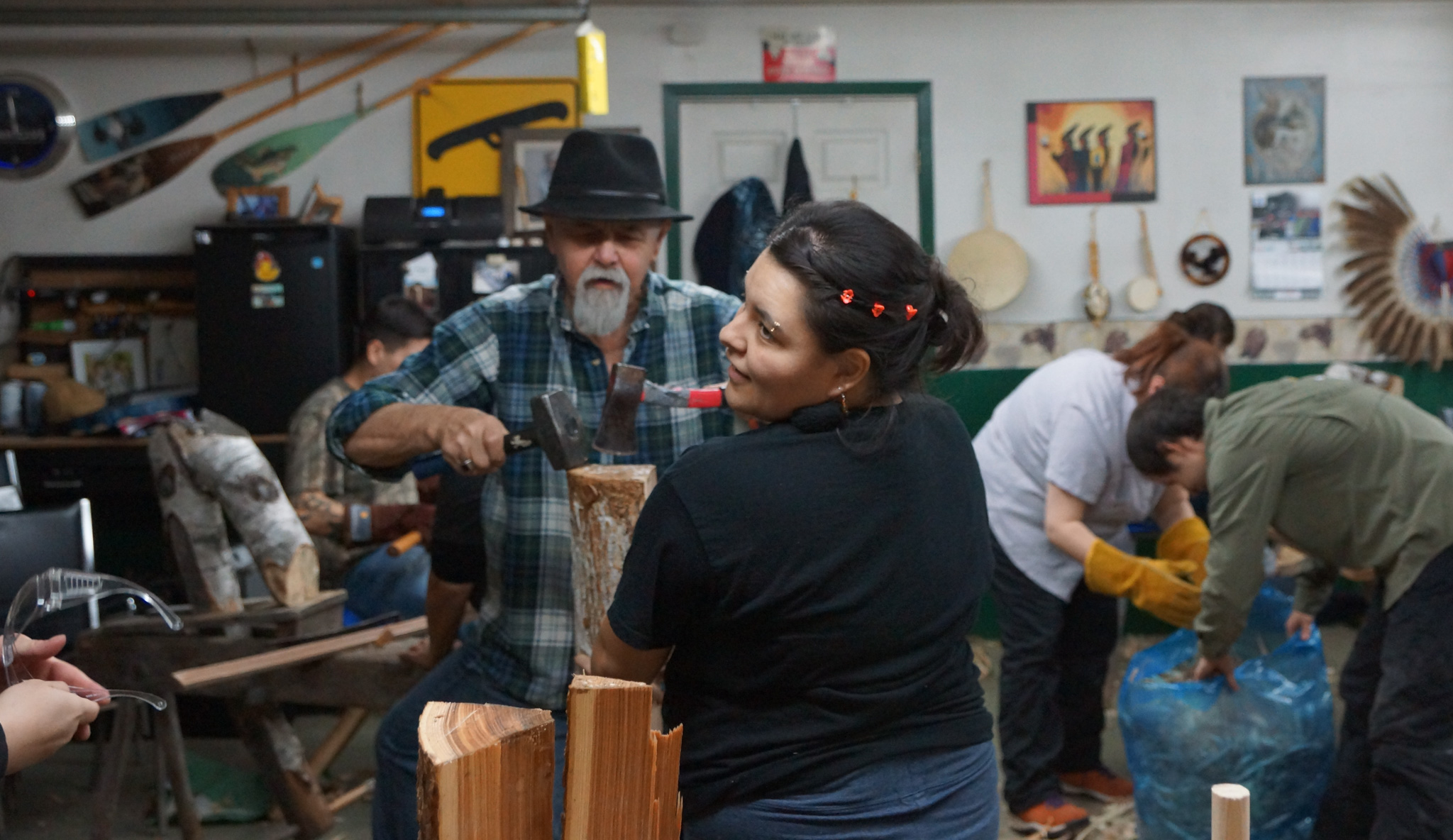
Pinock Smith hosted Guardian Dolcy Meness (front) and her team, as well as the Guardian unit from Pikwàkanagàn First Nation, for a sled-making workshop in January 2025. Over a week, they took turns splitting logs and bending fresh ash wood to make small sleds. The exercise was meant to foster a deeper relationship between their two units — and with the materials — by learning a traditional craft together. (Photo: Sarah St-Pierre)
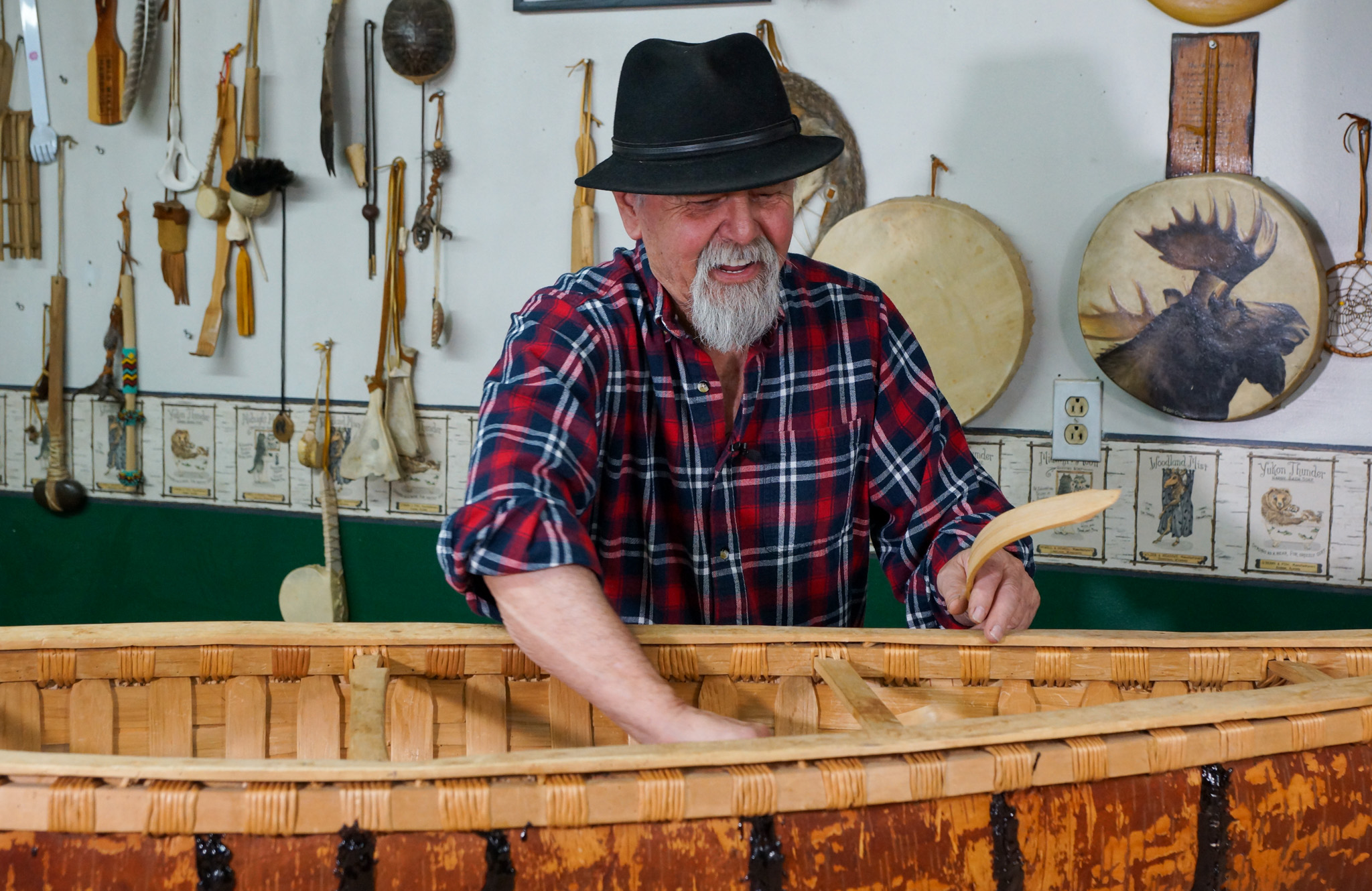
Smith’s workshops offer a targeted learning environment that keeps crafting knowledge alive — his ancestors’ knowledge, not his, he specifies. “I don’t know a damn thing,” he said. “It’s something that I [was] passed on, and I appreciate it, and I’d like other people to learn about it.” [Photo © Julia Stratton]
Compared with other species, white birch is a fast-growing but short-lived species that grows almost anywhere in the cooler climates of North America as long as the sun shines on it. For birds and animals living nearby, the buds, leaves and seeds from white birch are food. Woodpeckers often build nests in pockets between their branches.
However, it is among the deciduous tree species most vulnerable to climate change in Quebec, says Simon Baillargeon, a spokesperson for Quebec’s Ministry of Natural Resources and Forests, by email in French.
According to ministry projections, in a pessimistic scenario, 26 per cent of the white birch’s current habitat will become less favourable to the tree by the end of the century, especially in the southern areas of its distribution range, says Baillargeon.
The tree’s growth and survival will likely suffer from the climbing temperatures and more intense summer droughts associated with climate change, Baillargeon says.
Birch trees have shallow roots that make it harder to access groundwater during droughts, says Isabelle Aubin, a forest vegetation ecologist at Natural Resources Canada. Lack of water can lead to cavitation, which happens when air bubbles form in the tissues that transport water through the tree, like an embolism preventing water flow. White birch is known to be sensitive to drought because cavitation can severely disrupt its ability to take in water.
Warming temperatures also mean part of the birch’s range no longer falls in its climatic niche. As temperatures climb, their ideal climate will shift north, but the birch trees remain rooted in place.
While the species reproduces quickly enough to keep seeing new growth, Aubin says, more young birch trees may die before reaching maturity in the long term, keeping the overall population small.
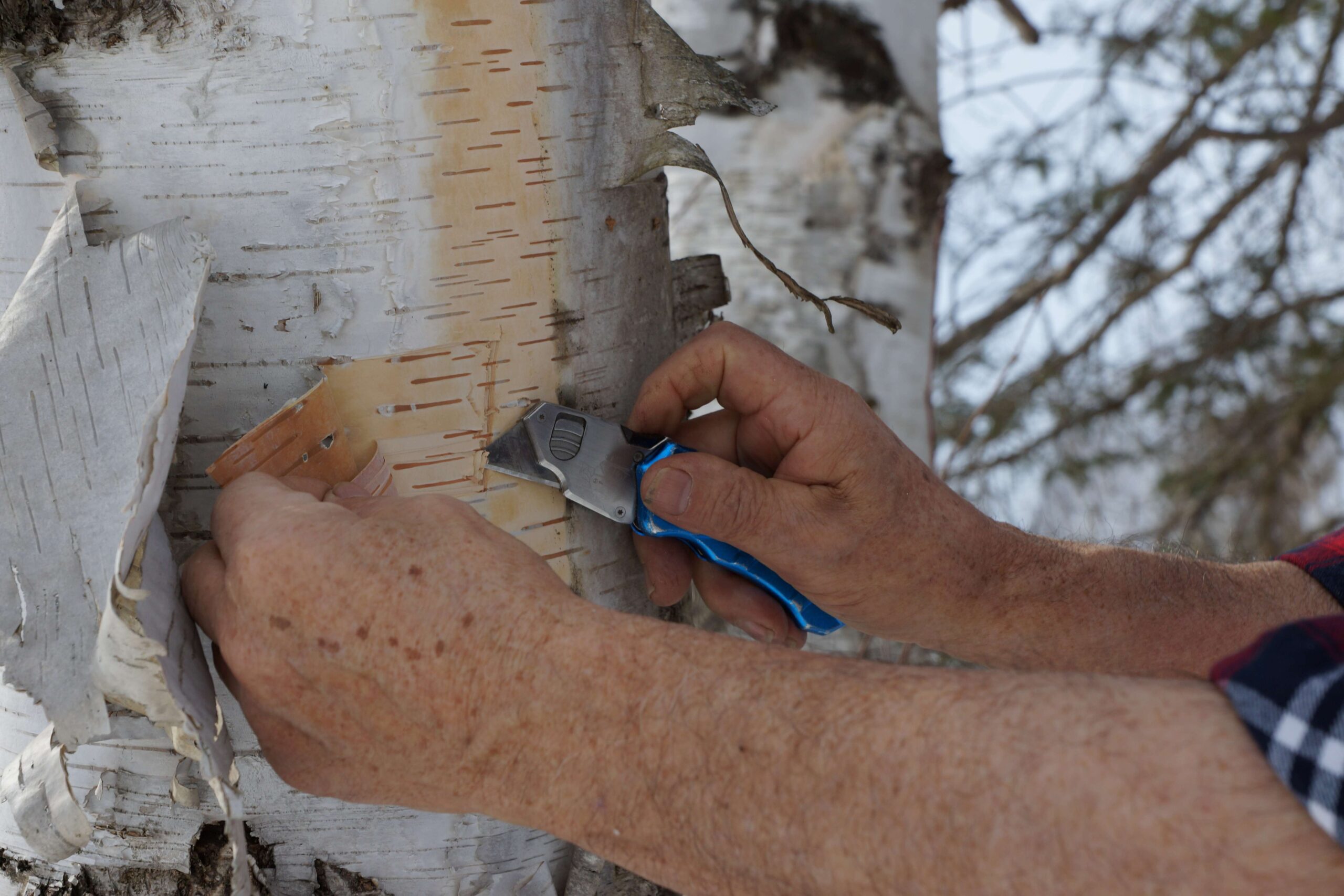
Pinock Smith harvests a small section of birch bark with a box cutter. Dolcy Meness, not pictured, explained that trying to harvest the birch bark when it’s too cold can fail because it can get stuck to the inner bark. But, if the weather is too hot, the oil in the bark will bubble, creating little spots and nubs on the outer layers of the bark. [Photo © Julia Stratton]
Due to the difficulty of sourcing birchbark, Smith says simply buying canoes is now much more popular than crafting them by hand. Many people opt to take the path of less resistance to meet their boating needs.
“There’s very few people doing what I’m doing,” he says. “There are people that know how to do it, but [they’re] not doing it.”
While there’s growing interest from younger generations in learning about crafting traditions, says Smith, the sourcing problem is affecting his ability to teach others. When he takes people out to harvest bark, he says it can be discouraging for them to realize how difficult it is to find it now.
Smith has taught some of what he knows to the Kitigan Zibi land Guardian unit Meness belongs to. Thanks to their work, worry is not met with inaction. They are not only monitoring the declining health of the birch tree in Kitigan Zibi; they are building a greenhouse to preserve native species, including white birch. Within each species, they look for trees with good genetics: strong, durable and plentiful in seeds. They then use seeds from those trees to populate certain areas.
Meness also helps the Guardians mark traditional harvesting locations and protect birch-rich areas from being exploited by the forestry industry. Identifying species doesn’t just help with information gathering; it’s evidence. “We have proof to tell them: no, this is a highly sensitive area,” she says. “That is just one of the ways that we can stop forestry companies from decimating our birch forest, our wiigwaas forest, and ensure that these trees are surviving for a long time and even in the next generation.”
In addition to preserving the birch trees, protecting the surrounding ecosystem will also be good news for shrew moles like the one who took a liking to Smith’s workshop. Their presence provides food and shelter for the animals scurrying along the forest floor.
In the meantime, Smith has been experimenting with stitching pieces of bark together rather than using a single one, as is the tradition. The additional stitching holds the canoe structurally but strays from tradition and makes for a less visually appealing canoe. If things reached a point where it became impossible to source bark at all, Smith says not even the extinction of birch could stop him from keeping the knowledge alive.
“I’d still make canoes,” he says. Just as he sometimes uses modern tools, he is wondering whether he could one day make a canoe using Tyvek, a waterproof synthetic material, rather than birchbark.
Part of his ancestors’ legacy, says Smith, is the way they used the resources available to them. “I’m just adapting to the environment that I’m living in, too.”
